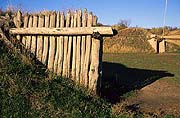| Through "the Garden" to India
Jefferson's knowledge of Northwest geography was derived from the writings and maps of explorers from many nations. The French were first to explore the eastern margins of the Louisiana Territory. During the 1600s they came down the St. Lawrence River, through the Great Lakes, and finally down the Mississippi River to the Gulf of Mexico, where they built New Orleans in the early 1700s.
French writers, perhaps in an effort to attract French settlers to the Mississippi/Missouri Valley, described the land as a "garden" with soil so rich that European crops would grow "almost without cultivation." The Mississippi and the soils on its banks were often compared to the Nile and its rich flood-renewed soils. Writers waxed eloquent describing the beauties of the prairies and the vast numbers of buffalo, elk, and deer that inhabited the region. Historical geographer John Logan Allen in his book, Passage Through the Garden:Lewis and Clark and the Image of the American Northwest, says:
| "Nearly two centuries of wilderness experience had apparently not served to quell the American unshakable belief that to the west there was an area where life was happy and blissful, where sickness, disease, and poverty were unknown, where people did not die. The West was a garden, and the fact had been known for centuries" (Allen, p. 43). |
But one of the greatest motivations for the French explorers was the hope of finding the fabled "Passage to India" and its promise of vast wealth through trade. Jolliet and Marquette's epic exploration down the Mississippi in 1762 was partly in hopes of finding an outlet into the Gulf of California—that is, the Pacific Ocean.
 |
A 1735 map showing the Missouri on a straight course west.
|
When the Mississippi proved to flow into the Gulf of Mexico instead, interest then centered on the Missouri River. The earliest maps show it as a small stream, but as exploration around its confluence with the Mississippi proved it to be a large river extending to the west, the Missouri became an important cartographic feature even though it was speculatively represented. For example, one map in 1735 showed the Missouri (called the Long River) extending straight as an arrow to a large lake in the distant West. Additionally, streams were drawn in hills surrounding the lake that flowed into a large river that flowed west, presumably to the Pacific—the water route to India! Even though the map was completely wrong west of the mouth of the Missouri, it expressed the expectation held by most of the existence of a water route across the continent that included a "Great River of the West" that flowed into the Pacific.
The Spanish explored the southern margins of the Northwest. Colonies formed in New Mexico and California during the mid-1700s. The desire to link up the colonies led to the Escalante expedition through central Colorado and Utah in 1776. Escalante's party was hindered by huge mountains, deep canyons, and terrible deserts. It returned to Santa Fe without reaching California or any of the river systems of the Northwest.
 |
| Mandan villages were discovered to be important trade centers for Indians and Europeans. Lewis and Clark wintered in those villages during their journey. Image © 2002 www.clipart.com. |
The Spanish took over the Louisiana Territory after 1763 (a result of the French and Indian War). Their extension of French exploration of the region, driven largely by the fur trade, yielded two important ideas. The first was a more realistic view of the dryness of the prairie, particularly the western portions. The prairie was not quite the "garden" portrayed by the French. The second was the recognition of the Knife River (Mandan) villages on the upper Missouri as an important trade center for both Indians and Europeans. This latter information fixed the villages as an important objective for Lewis and Clark.
< back | next > |



